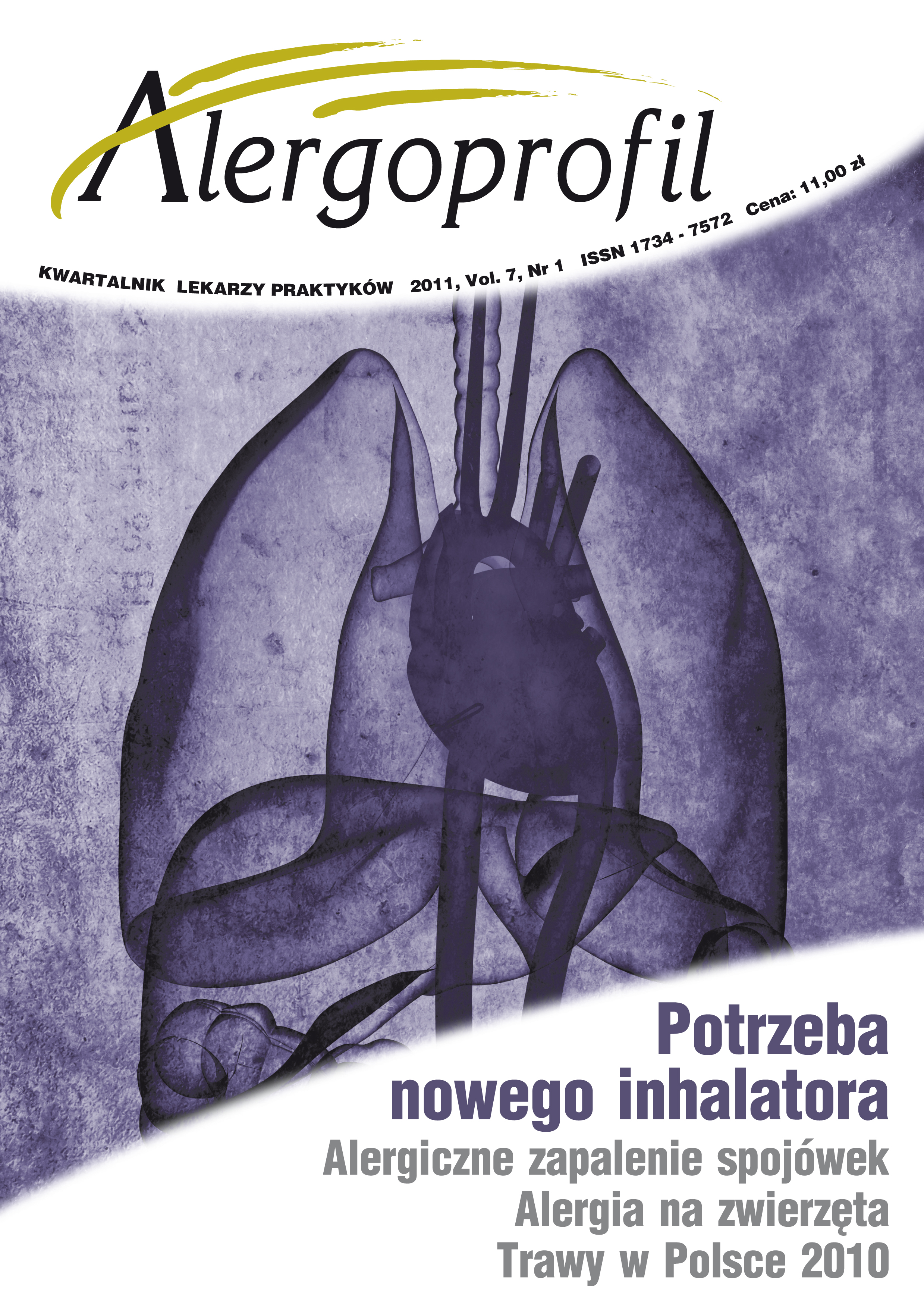Alergia na zwierzęta
##plugins.themes.bootstrap3.article.main##
Abstrakt
W ostatnich dziesięcioleciach obserwowany jest systematyczny wzrost liczby chorych z alergią na zwierzęta. W znacznej mierze jest to konsekwencją zmian trybu życia i większej ekspozycji na ten rodzaj alergenu. Nawet w domach bez zwierząt rejestrowane są podwyższone stężenia ich alergenów. W artykule przedstawiono najważniejsze alergeny zwierzęce, a także diagnostykę, prewencję oraz leczenie chorób związanych z tymi alergenami, takich jak alergiczny nieżyt nosa i astma.
Pobrania
##plugins.themes.bootstrap3.article.details##
Copyright: © Medical Education sp. z o.o. This is an Open Access article distributed under the terms of the Attribution-NonCommercial 4.0 International (CC BY-NC 4.0). License (https://creativecommons.org/licenses/by-nc/4.0/), allowing third parties to copy and redistribute the material in any medium or format and to remix, transform, and build upon the material, provided the original work is properly cited and states its license.
Address reprint requests to: Medical Education, Marcin Kuźma (marcin.kuzma@mededu.pl)
Bibliografia
2. American Veterinary Medical Association.U.S. Pet Ownership & Demographics Sourcebook 2007.
3. de Groot H., Goei K.G., van Swietn P. et al.: Affinity purification of major and minor allergen from dog extract. J. Allergy Clin. Immunol. 1991, 87: 1056-1065.
4. Takkouche B., Gonza lez-Barcala F.J. et al.: Exposure to furry pets and the risk of asthma and allergic rhinitis. Allergy 2008, 63: 857-864.
5. Samoliński B. et al.: Epidemiologia alergii i astmy w Polsce – doniesienie wstępne badanie ECAP. Terapia 2008, 10: 41-47.
6. Krawiec M., Krauze A., Borkowska A.: Epidemiologia alergii wziewnych w grupie pacjentów Kliniki Pneumonologii i Alergologii Wieku Dziecięcego I Katedry Pediatrii Warszawskiego Uniwersytetu Medycznego. Alergoprofil 2008, 4: 20-24.
7. Gronlund H., Saarne T., Gfvelin G.: The major cat allergen Fel d 1,I diagnosis and Therapy. Int. Arch. Allergy Immunol. 2010, 151: 265-274.
8. Liccardi G., Barber D., Russo M. et al.: Human hair: An unexpected source of cat allergen exposure. Int. Arch. Allergy Immunol. 2005, 137: 141-144.
9. Ramadour M., Birnbaum J., Megalon C. et al.: Cat sex differences in major allergen production (Fel d 1). J. Allergy Clin. Immunol. 1998, 101: 282-4.
10. Almqvist C., Wickman M., Perfetti L. et al.: Worsening of asthma in children allergic to cats, after indirect exposure to cat at school. Am. J. Respir. Crit. Care Med. 2001, 163: 694-698.
11. Ritz B.R., Hoelscher B., Frye C. et al.: Allergic sensitization owing to “second-hand”cat exposure in schools. Allergy 2002, 57: 357-361.
12. Hilger C., Kohnen M., Grigioni F. et al.: Allergic cross-reactions between cat and pig serum albumin. Allergy 1997, 52: 179-87.
13. Martinez A., Martinez J., Sanz M.L. et al.: Dander is the best epithelial source for dog allergenic extract preparations. Allergy 1994, 49(8): 664-7.
14. Ramadour M., Guetat M., Guetat J. et al.: Dog factor differences in Can f 1 allergen production. Allergy 2005, 60: 1060-1064.
15. Basagana M., Bartolome B., Pastor C. et al.: Allergy to human seminal fluid: Cross-reactivity with dog dander. J. Allergy Clin. Immunol. 2008, 121: 233-239.
16. Weidinger S., Mayerhofer A., Raemsch R. et al.: Prostatic – specific antigen as allergen in human seminal plasma allergy. J. Allergy Clin. Immunol. 2006, 117: 213-215.
17. Roberts G., Lack G.: Horse allergy in children BMJ 2000, 321: 286-7.
18. Bush R.K., Wood R.A., Eggleston P.A.: Laboratory animal allergy J. Allergy Clin. Immunol. 1998, 102: 99-112.
19. Wallace D.V.: Pet dander and perenial allergic rhinitis: therapeutic options. Allergy Asthma Proc. 2009, 30: 573-583.
20. NAEPP. Expert Panel Report 3: Guidelines for the Diagnosis and management of Asthma Full Report 2007.
21. Kilburn S.A., Lasserson T.J., McKean M.C.: Pet allergen control measures for allergic asthma in children and adults (Review). Cochrane Database of Systematic Reviews 2001, issue 1.
22. Gore R.B., Bishop S., Durrell B., Curbishley L., Woodcock A., Custovic A.: Air filtration units in homes with cats: can reduce personal exposure to cat allergen? Clin. Exp. Allergy 2003, 33: 765-769.
23. Nageotte C., Park M., Havstad S., Zoratti E., Ownby D.: Duration of aiborne Fel d1 reduction after cat washing. J. Allergy Clin. Immunol. 2006, 118: 521-522.
24. Alvarez-Cuesta E., Berges-Gimeno P., Gonzalez-Mancebo E., Fernandez-Caldas E., Cuesta-Herranz J., Casanovas M.: Sublingual immunotherapy with standardized cat dander extract: evaluation of efficacy in a double blind placebo controlled study. Allergy 2007, 62(7): 810-817.

